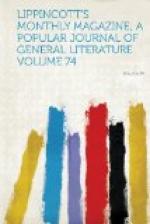They aided to infect him, if free from it before, with
the Centennial craze. Their doors, though sealed,
were eloquent, for they bore in great black letters
on staring white muslin the shibboleth of the day,
“1776—International Exhibition—1876.”
The enthusiasm of those very hard and unimpressible
entities, the railroad companies, thus manifesting
itself in low rates and gratuitous advertising, could
not fail to be contagious. Nor was the service
done by the interior lines wholly domestic. Several
large foreign contributions from the Pacific traversed
the continent. The houses and the handicraft of
the Mongol climbed the Sierra Nevada on the magnificent
highway his patient labor had so large a share in
constructing. Nineteen cars were freighted with
the rough and unpromising chrysalis that developed
into the neat and elaborate cottage of Japan, and
others brought the Chinese display. Polynesia
and Australia adopted the same route in part.
The canal modestly assisted the rail, lines of inland
navigation conducting to the grounds barges of three
times the tonnage of the average sea-going craft of
the Revolutionary era. These sluggish and smooth-going
vehicles were employed for the carriage of some of
the large plants and trees which enrich the horticultural
department, eight boats being required to transport
from New York a thousand specimens of the Cuban flora
sent by a single exhibitor, M. Lachaume of Havana.
Those moisture-loving shrubs, the brilliant rhododendra
collected by English nurserymen from our own Alleghanies
and returned to us wonderfully improved by civilization,
might have been expected also to affect the canal,
but they chose, with British taste, the more rapid
rail. They had, in fact, no time to lose, for
their blooming season was close at hand, and their
roots must needs hasten to test the juices of American
soil. Japan’s miniature garden of miniature
plants, interesting far beyond the proportions of its
dimensions, was perforce dependent on the same means
of conveyance.
[Illustration: Facade of the Egyptian
division, main building.]
The locomotive was summoned to the aid of foreign
exhibitors on the Atlantic as on the Pacific side,
though to a less striking extent, the largest steamships
being able to lie within three miles of the exposition
buildings. It stood ready on the wharves of the
Delaware to welcome these stately guests from afar,
indifferent whether they came in squadrons or alone.
It received on one day, in this vestibule of the exposition,
the Labrador from France and the Donati from Brazil.
Dom Pedro’s coffee, sugar and tobacco and the
marbles and canvases of the Societe des Beaux-Arts
were whisked off in amicable companionship to their
final destination. The solidarity of the nations
is in some sort promoted by this shaking down together
of their goods and chattels. It gives a truly
international look to the exposition to see one of
Vernet’s battle-pieces or Meissonier’s
microscopic gems of color jostled by a package of
hides from the Parana or a bale of India-rubber.




